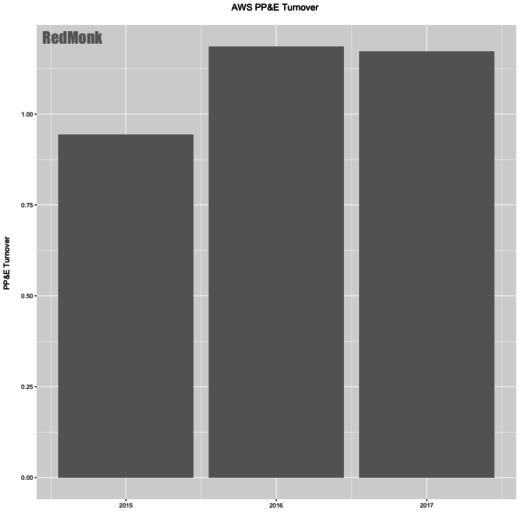I was reading through Amazon’s 2017 10-K and was drawn to some of their published metrics specific to Amazon Web Services.
Amazon began breaking out AWS as its own segment starting in 2015, so we now have three years of high level data for that line of business. I previously explored PP&E investments across providers, but in this case I was interested in seeing how capital investments specific to AWS have changed over time.
Fixed-asset turnover is a productivity ratio, i.e. a metric that shows how efficiently a business is operating. Productivity ratios can generally be understood as output divided by input (or ‘what financial results have been driven given how much has been invested in the business’), and generally speaking higher ratios are better. In this case, we’re interested in exploring how the AWS segment is using its capital investments in data centers to drive sales, or Net Sales / Net PP&E*.
Not only do we see AWS increasing their capital investments in data centers on an absolute basis, but as evidenced by the asset turnover ratio we also see that AWS has improved their ability to convert their data center investments into sales over the past three years. AWS’ asset turnover ratios indicate that since 2015 AWS has improved their ability to turn their infrastructure investments into additional revenue, though those efficiency gains leveled off between 2016 and 2017.
The charts also lead to some questions. Did Amazon’s large 2015 PP&E investments (in excess of their sales that year) pave the way for 2016-2017’s PP&E efficiency gains? How sustainable is this turnover ratio given current investment levels? Can we expect continued efficiency gains or is the recent leveling off a trend that will continue? With only three years of publicly available information, these are questions that we can’t currently answer but are areas that we will continue to watch.
We posit that competitiveness in the cloud market is considerably dependent upon companies’ infrastructure investments. Thus it is worthwhile not only to track overall investment levels but also the efficiency of those investments over time.
* I’m aware that PP&E is a component of fixed assets – not a synonym – but in the case of AWS the data center investments in PP&E comprise the majority of the segment’s assets. For that reason this modified ratio is still a good gauge of the effectiveness of AWS’ long-term investment efficiency.
Disclosure: AWS is a RedMonk client.


No Comments